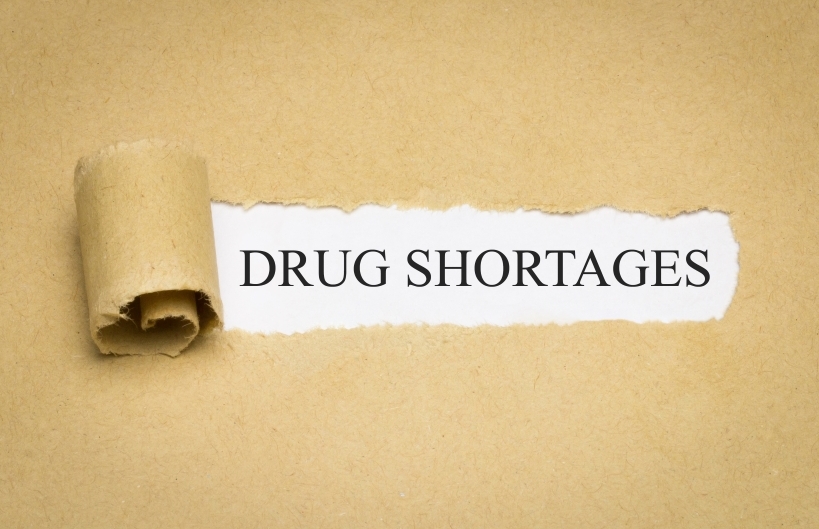Drug shortages have existed for many decades but not to the extreme that they are today. The pandemic (COVID) and how we treated patients, highlighted the extreme vulnerability of the whole drug supply chain in the United States, especially for generic injectable drugs, which are some of the most frequently used drugs in a hospital setting of patient care, from neuromuscular blockers, anti-infectives and oncology drugs. We rely on some of the cheapest drugs and we count on them to be available, to provide patient care for various diseases and indications and to support patient care service lines, such as oncology and pediatrics.
We need to remember, that the generic drugs that are in short supply, are classified as “small molecule drugs” and not “branded drugs or biosimilars” and some, maybe generic for 25 years or more. Branded Drug Companies own the API source/supply for their small molecule drugs, if they have the patent/NDA. Generic drug companies don’t have medical science liaisons (MSLs) and normally, don’t do any research to expand the FDA approved indication of a drug or develop a different vial size, when they decide to manufacture the generic (this requires a separate ANDA that can take up to 2 years). Generic Drug Companies file for an ANDA (Abbreviated New Drug Application) with the FDA and have their own professional organization, the Generic Pharmaceutical Association, representing them in Washington DC and with the FDA.
As we enter 2024, there are still no solutions that have been implemented policy wise, by the FDA and legislatively, to address the Drug Shortage issue, and the same questions. There have been many meetings and hearings in Washington DC being held with the FDA and Committees, such as Energy and Commerce, with representatives from many different professional organizations, clinicians who treat patients, and even patients and their families, impacted by drug shortages, but still no actions, policies, or legislation being presented for review and approval, to solve the drug shortage crisis. There are discussions about the role of the FDA in the approval process of generic drugs, as well as the role of each generic manufacturer and their professional organization, the Generic Pharmaceutical Association. Drug shortages have been blamed on drug costs being too low for generic drug companies to sustain a profit (race to the bottom), to API shortages and country of API origin, to lack of quality in manufacturing (cGMP), geographical location of manufacturing facilities and exposure to natural disasters, lack of FDA inspections or timely inspections, lack of communication to the FDA on a drug shortage by generic companies and the reason for the drug shortage and the supply chain. Generic drugs are not only purchased and distributed to hospitals, but physician practices (e.g. oncology), 503Bs for compounding (sterile to sterile), private payer infusion companies and various home infusion companies. Sometimes generic drugs end up in what we call the grey market. A more recent concern that has arisen, is the impact of geo-political issues on the global supply chain of drugs.
To develop long-term solutions, there needs to be an understanding of the whole process/steps in developing a generic drug and address each step accordingly with a solution, until it gets to the end user to administer to a patient. Some of the legislation and changes being recommended as solutions, regarding generic drugs, can and will impact the drug supply chain, availability of generic drugs and ability to order drugs to treat patients.
One program being established by the Center for Drug Evaluation and Research (CDER) is the Quality Management Maturity (QMM) Program. The Goals of QMM are 1. Foster a strong quality culture mindset. 2. Recognize establishments that have advanced quality management practices and acknowledge establishments that strive to continually improve quality management practices. 3. Identify areas where quality management practices can be enhanced and provide suggestions for growth opportunities. 4. Minimize risks to product availability to assure reliable market supply.
A second program is Senate Bill S.2510, the RAPID Reserve Act (Rolling Active Pharmaceutical Ingredient and Drug Reserve Act”, which addresses building and maintaining reserves of critical medications and their key ingredients, including API (active pharmaceutical ingredients), and reducing reliance on foreign drug manufacturers.
The Pediatric Cancer Drug Supply Act of 2024 was recently proposed and directs the U.S. Department of Health and Human Services (HHS) to establish a program to create a reserve supply of essential pediatric cancer drugs. HHS would contract with eligible drug manufacturers to produce a stockpile of the most essential pediatric cancer drugs. As part of the contract, drug manufacturers would receive payments from HHS based on the quantity and cost of pediatric cancer drugs held in reserve. HHS would have authority to order manufacturers to distribute drugs from the buffer stocks into the commercial market to alleviate or prevent drug shortages.
As we continue into 2024 my thought is that there will be some reasonable discussion, decisions and appropriate solutions being approved by the FDA and legislatively, so we can get back to delivering patient care, sooner, rather than later. If there is no drug, there is no Value!



